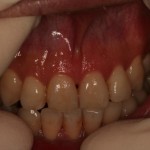What is a frenectomy?
Frenectomy is a surgical procedure which involves the removal of frenum, a thin band of fibrous tissue covered with mucosa. Labial frenum can be found when you lift your upper lips and it connects the center of your upper lip to the gum tissues between your two front teeth. Lingual frenum is found extending from the floor of the mouth to the midline of your tongue.
Ankyloglossia is a developmental anomaly where by the movement of tongue is restricted by the presence of thick, short lingual frenum.
When is frenectomy indicated?
Frenectomy is indicated when the attachment of frenum is so close to the margins of gum that it may interfere with plaque removal. It is also an indication to perform frenectomy prior orthodontic treatment to close the gap between your front teeth. Removal of lingual frenum is also indicated if your lingual frenum is hindering your tongue movement and your speech development.
 How do I check for abnormal frenal attachment?
You can check for abnormal frenal attachment by performing a blanch test. Lift your lips and pull it outwards. Presence of blanch while pulling your lips outwards indicates a high labial frenal attachment. To check for abnormal lingual frenum, ask your child to protrude his/her tongue tip. Patients with ankyloglossia are not able to extend their tongue and the tongue may appear heart shaped on the tip during protrusion of tongue.
What are the problems associated with abnormal frenal attachment?
LABIAL FRENUM:
1)Â Â Â Â Â Midline diastemma
Labial frenum can extend to the area between your front teeth (the central incisors) and cause a space to develop in between them.
2)Â Â Â Â Â Gingival recession
Abnormal frenum attachment may result in pulling of gums away from your teeth. Gingival recession refers to exposure in the roots of teeth.
3)Â Â Â Â Â Interferes with plaque removal
As we have mentioned earlier, the attachment of frenum can be so close to your gum margins and you might not be able to clean the area effectively.
LINGUAL FRENUM:
1)Â Â Â Â Â Interferes with your denture stability
When your tongue moves, your frenal attachment might get tensed up and causing your lower denture to dislodge.
2)Â Â Â Â Â SPEECH PROBLEMS
Tongue tied patients might have difficulty in pronouncing certain sounds such as ‘t’, ‘h’ and ‘n’
However, some patients do not have speech problems due to natural compensation or with the help of speech pathologists. The ability to compensate varies between patients to patients.
What is the management of abnormal frenal attachment?
Management of abnormal frenal attachment can be done by surgical excision, laser or electrocautery.Â
Below are some brief explanations on how surgical frenectomy is performed.
- After local anesthesia is given by the dental practitioner, your lips will be pulled or extended.
- The labial frenum is gripped with a special forceps.
- The dental practitioner will then make an incision using a surgical blade. The triangle of frenal tissue will come off easily if the incision is made carefully.
- Sutures are then placed over the wound.
In lingual frenectomy, the frenum is held with a forceps and a triangular section is removed and sutures are placed over the wound.
What is laser frenectomy?
Laser frenectomy is another alternative which can be used to remove your abnormal frenal attachment. In laser frenectomy, there will be less post operative pain and scarring compared to normal surgical procedure and no suturing is required.
